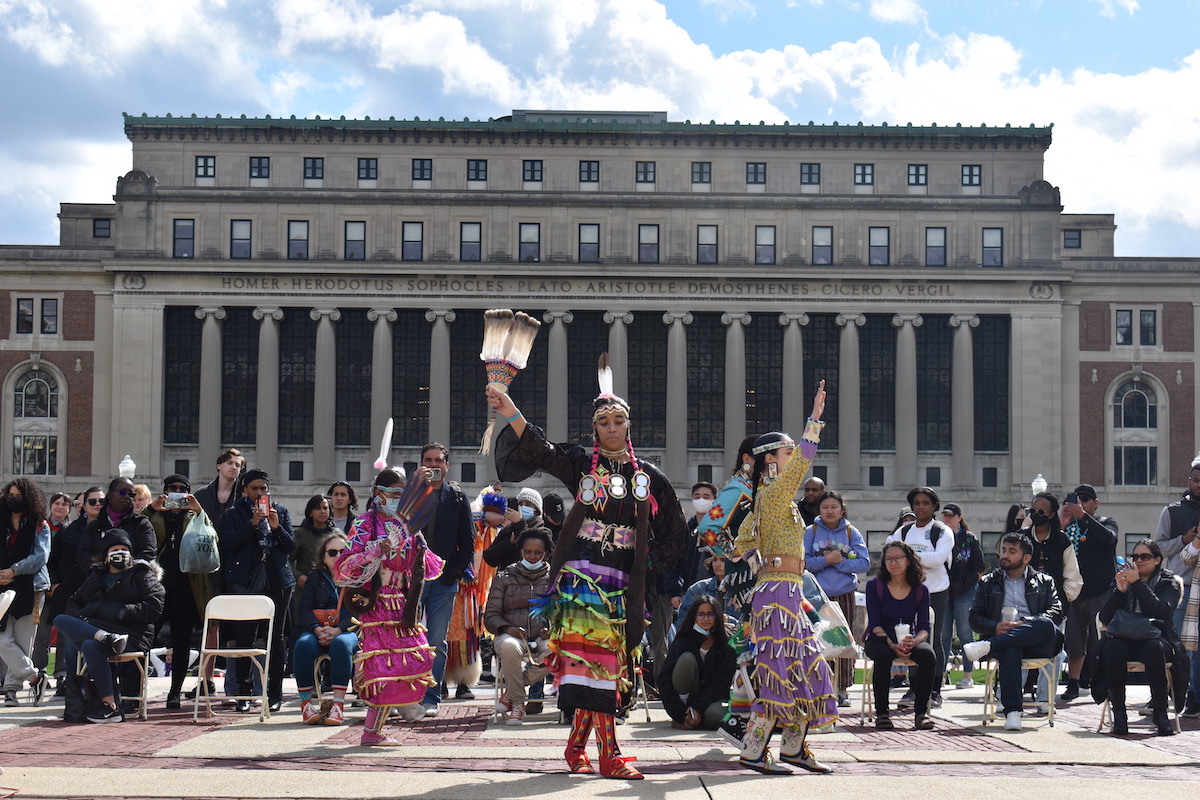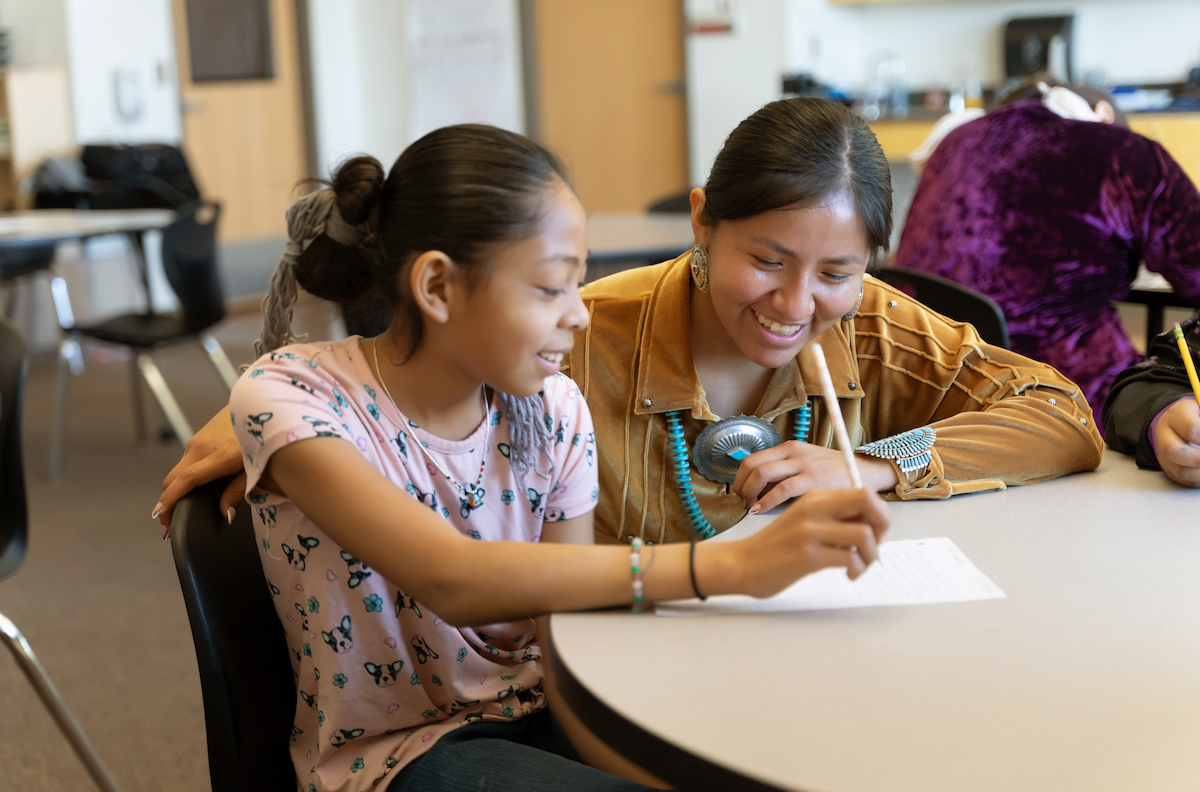The violent history of America’s colonization includes the death of 55 million Indigenous people — directly at the hands of settlers and from exposure to invasive illnesses — between 1492 and 1600, followed by centuries of additional systemic violence and mistreatment. And yet, American K-12 history lessons often omit key details that are critical to understanding the magnitude of not only the country’s violent past, but also the policy that continues to impact Indigenous people today.
Take, for example, the 1835 Treaty of New Echota, which granted the Cherokee Nation the right to send a delegate to the U.S. Congress. Despite this agreement, Congress has yet to seat the Cherokee’s delegate, Kim Teehee, selected in 2019.
“If you didn’t know that, someone didn’t teach you that,” explains Rachel Talbert, the Minority Postdoctoral Fellow at TC’s Edmund W. Gordon Institute for Urban and Minority Education, who discussed the issue during her colloquium at TC earlier this fall. “And if you don’t even know that there is a treaty, then how can you as an American citizen actively participate in voting for elected officials who are making decisions about current issues impacting Indigenous people?”

Rachel Talbert, the Minority Postdoctoral Fellow at TC’s Edmund W. Gordon Institute for Urban and Minority Education. (Photo courtesy of Talbert)
This core principle of civic participation is at the crux of Talbert’s research on the experiences of Indigenous high school students in Washington, the impact of the state’s Since Time Immemorial Curriculum” and participation in a Native Youth Council on their civic identities. Here’s what other educators can keep in mind to build more rewarding, accurate curriculum:
Acknowledge the colonized nature of civics and social studies curriculum.
The overwhelming majority of U.S. history content about Indigenous people covers events occurring before the 20th century, according to previous research by Sarah Shear and colleagues. Talbert notes that this approach centers a “frontier” view that not only emphasizes assimilation, but also means that curriculum fails to cover numerous significant events that occurred between the federal government and Indigenous people beyond the 1800s.
Shear, Talbert and other scholars suggest that keeping more recent and current issues facing Indigenous people out of the classroom leads to people thinking about Native Americans as historic and not contemporary members of the nation. Social studies curricula “doesn’t challenge [traditional] American ideas,” says Talbert, but educators addressing “settler narratives” and education’s own historic role in Indigenous erasure can help.
Discuss Indigenous experiences of the past and present to A) cultivate civic identity and B) help everyone participate in the democratic process.
A core function of teaching social studies is helping students cultivate civic identity — which experts agree plays a key role in fostering political participation later in life, and is primarily formed between 7th and 12th grade. This, Talbert argues, means that better incorporating Indigenous history and social issues is essential to equitably fostering civic participation and social justice among all students.
“We know that political efficacy among students is key to active, informed participation in their government, and part of continued survivance, a term coined by Gerald Vizenor which refers to the ‘sense of native presence over absence,’” says Talbert, who notes it is important to center the presence of Native peoples in curricular spaces.

Last spring, students celebrate at the 10th annual powwow hosted by the Native American Council, a Columbia student organization “that represents over 20 Native and Indigenous nations across the Americas and Pacific Islands.” (Photo: Takashi Williams / Columbia Daily Spectator)
In her research in social studies classes at a Pacific Northwest high school and a Native Youth council, Talbert observed that empowering students to share their own experiences can strengthen cross-cultural learning for everyone.
“Students in urban school spaces who are Indigenous have a lot of this knowledge, and this was allowing them a space [to share their experiences],” Talbert said, reflecting that one 11th grader was not only relatively familiar with his tribe’s legal battles with state government — but also committed to aiding efforts to help regain land. “I always tell teachers to ask students in their class about their experiences, because you might be surprised how their lives relate to these issues.”
As Talbert continues her research working with Native youth in other urban cities to learn more about civic identity, build a research case and advocate for for Indigenous civic education for all, educators can find resources below:
Resources
Tools for Educators
- Smithsonian National Museum of the American Indian’s “Native Knowledge 360° Education Initiative”
- Unsettling Settler-Colonial Education by Cornel Pewewardy, Anna Lees and Robin Zape-tah-hol-ah Minthorn (TC Press, 2022)
- Native Presence and Sovereignty in College by Amanda R. Tachine (TC Press, 2022)
- Indian Education for All by John P. Hopkins (TC Press, 2020)
- To Remain an Indian by K. Tsianina Lomawaima and Teresa L. McCarty (TC Press, 2006)
Books for Younger Readers
- We Are Still Here by Traci Sorell (Penguin Random House, 2021)
- We Are Water Protectors by Carole Lindstrom (Macmillan, 2020)
- I Am Not a Number by Jenny Kay Dupuis and Kathy Kacer (Second Story Press, 2016)
NYC Experiences
- The American Indian Community House
- Smithsonian National Museum of the American Indian
- “Water Memories” at the Metropolitan Museum of Art
More on the Lenape People, Native to Manhattan
- Resources from the Lenape Center
- An online exhibit from the Brooklyn Public Library
- “The Manhatta Project” from Columbia Magazine
The above websites and organizations are not affiliated with Teachers College. The views expressed are solely those of the speaker to whom they are attributed. They do not necessarily reflect the views of the faculty, administration, staff or Trustees of Teachers College or of Columbia University.
